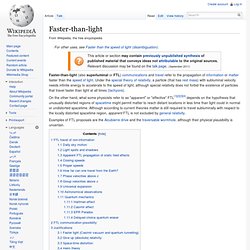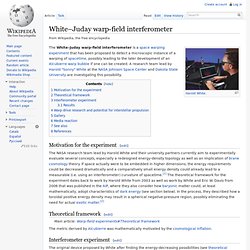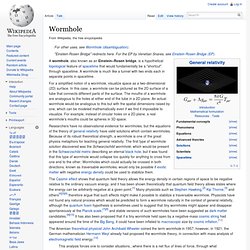

Faster than Light Travel. Faster-than-light. Faster-than-light (also superluminal or FTL) communications and travel refer to the propagation of information or matter faster than the speed of light.

Under the special theory of relativity, a particle (that has rest mass) with subluminal velocity needs infinite energy to accelerate to the speed of light, although special relativity does not forbid the existence of particles that travel faster than light at all times (tachyons). On the other hand, what some physicists refer to as "apparent" or "effective" FTL[1][2][3][4] depends on the hypothesis that unusually distorted regions of spacetime might permit matter to reach distant locations in less time than light could in normal or undistorted spacetime.
Although according to current theories matter is still required to travel subluminally with respect to the locally distorted spacetime region, apparent FTL is not excluded by general relativity. FTL travel of non-information[edit] Daily sky motion[edit] Light spots and shadows[edit] Alcubierre drive. White–Juday warp-field interferometer.
Motivation for the experiment[edit] The NASA research team lead by Harold White and their university partners currently aim to experimentally evaluate several concepts, especially a redesigned energy-density topology as well as an implication of brane cosmology theory.

If space actually were to be embedded in higher dimensions, the energy requirements could be decreased dramatically and a comparatively small energy density could already lead to a measurable (i.e. using an interferometer) curvature of spacetime.[1] The theoretical framework for the experiment dates back to work by Harold White from 2003 as well as work by White and Eric W. Davis from 2006 that was published in the AIP, where they also consider how baryonic matter could, at least mathematically, adopt characteristics of dark energy (see section below). Theoretical framework[edit] NASA Starts Work on Real Life Star Trek Warp Drive. Technical Reports Server - Eagleworks Laboratories: Advanced Propulsion Physics Research.
Daydreaming Beyond the Solar System with Warp Field Mechanics. This article was authored by Harold “Sonny” White and Catherine Ragin Williams Sure and is a submission of the Exotic Research Group of Icarus Interstellar. Sure, the Red Planet or an asteroid are enticing destinations, but what if one day we wanted to go really, really far out? With the technology we have today, it’s not in the realm of possibility. But it could be … and the Eagleworks Laboratories at Johnson Space Center are doing the mathematics and physics required to find the answers that defy traditional Newtonian laws. Enter: The space warp. It’s the same space, and the same standard of time, but if we can theoretically manipulate it for our purposes, interstellar flight could be an option on a future technology roadmap.
Back in the 1970s, the British Interplanetary Society looked into what it would take to send a robotic probe to reach Barnard’s Star, about 6 light years (or 380,000 AU) away, within 50 years. The loopholes, amazingly, can be found in mathematical equations. NASA Admits They Are Working To Travel Faster Than The Speed Of Light. NASA is currently working on the first practical field test toward the possibility of faster than light travel.

Traveling faster than light has always been attributed to science fiction, but that all changed when Harold White and his team at NASA started to work on and tweak the Alcubierre Drive. Special relativity may hold true, but to travel faster or at the speed of light we might not need a craft that can travel at that speed. The solution might be to place a craft within a space that is moving faster than the speed of light! Therefore the craft itself does not have to travel at the speed of light from it’s own type of propulsion system. It’s easier to think about if you think in terms of a flat escalator in an airport. What is the Alcubierre Drive? This type of concept was also recently illustrated by Mathematician James Hill and Barry Cox at the University of Adelaide. Wormhole. A wormhole, also known as an Einstein–Rosen bridge, is a hypothetical topological feature of spacetime that would fundamentally be a "shortcut" through spacetime.

A wormhole is much like a tunnel with two ends each in separate points in spacetime. New Wormhole Theory Uses Space Photon Energy “Fluid” A new theory expands on other theories and adds photon energy “fluid” as a way to support wormholes.

The introduction to the paper states the following. Wormholes are hypothetical geometrical structures connecting two universes or two distant parts of the same universe. For a simple visual explanation of a wormhole, consider spacetime visualized as a two-dimensional (2D) surface. If this surface is folded along a third dimension, it allows one to picture a wormhole “bridge”. [1] “A possible cause of the late-time cosmic acceleration is an exotic fluid with an equation of state lying within the phantom regime, i.e., w = p/ρ < −1.
FIG. 1: The plot depicts the function H(x, a), for α = 1/2 and where the parameter x = r0/r, lying in the range 0 < x ≤ 1, has been defined in order to define the entire spacetime. By using this theory an advanced civilization would , in theory, be able to mine photon “fluid” for Phantom Energy to construct micro worm holes for such things as transportation. 1. 2.